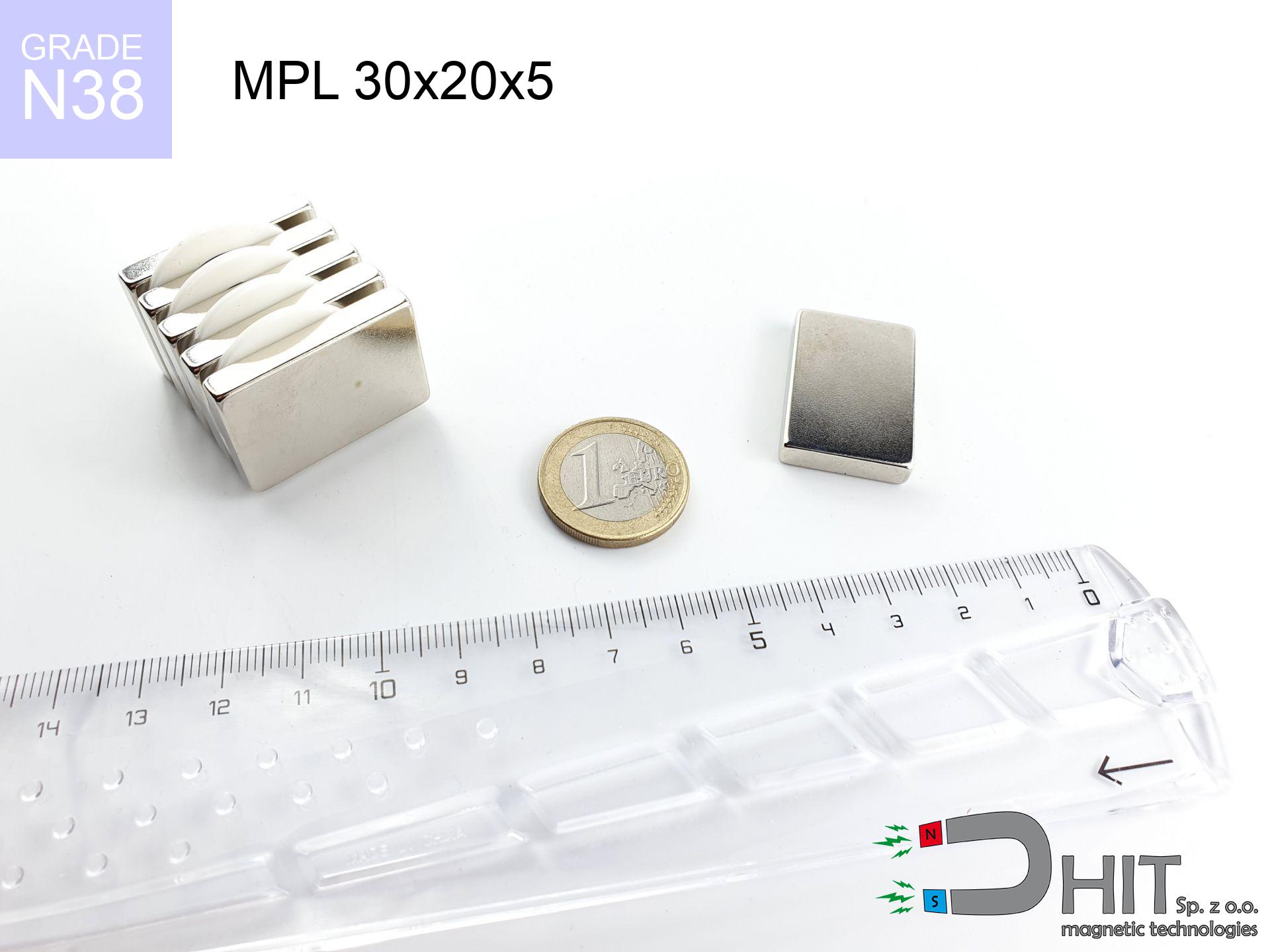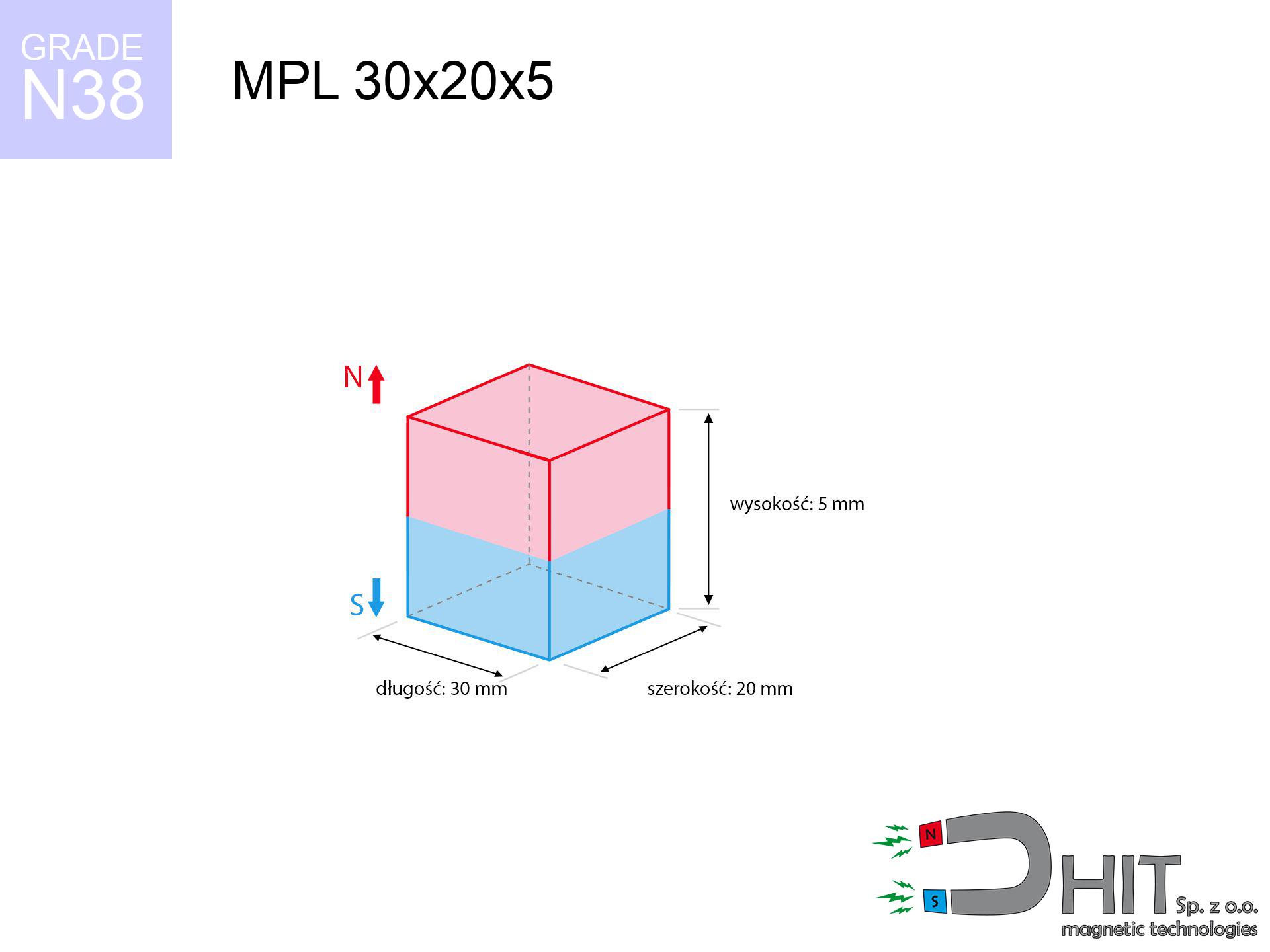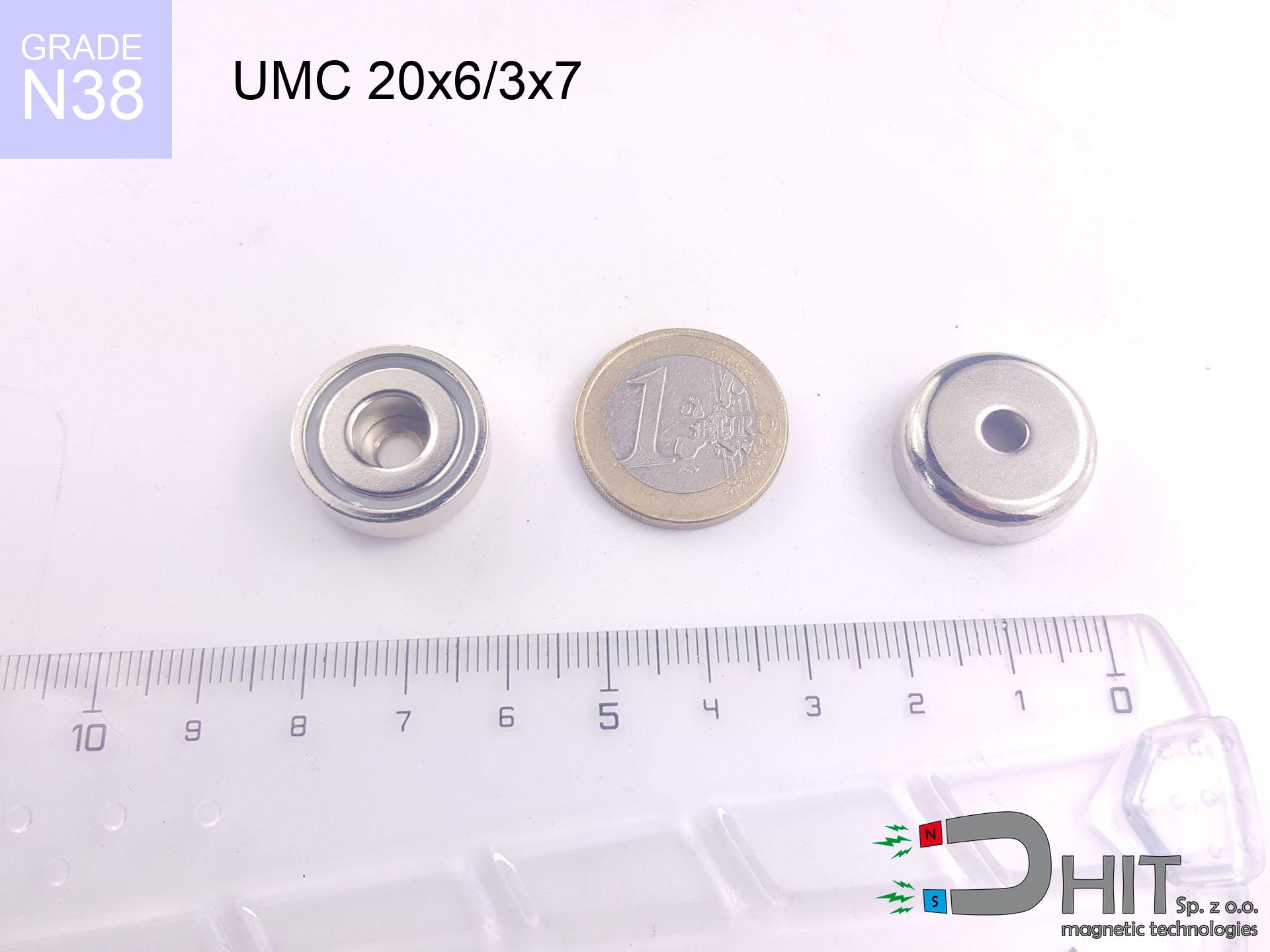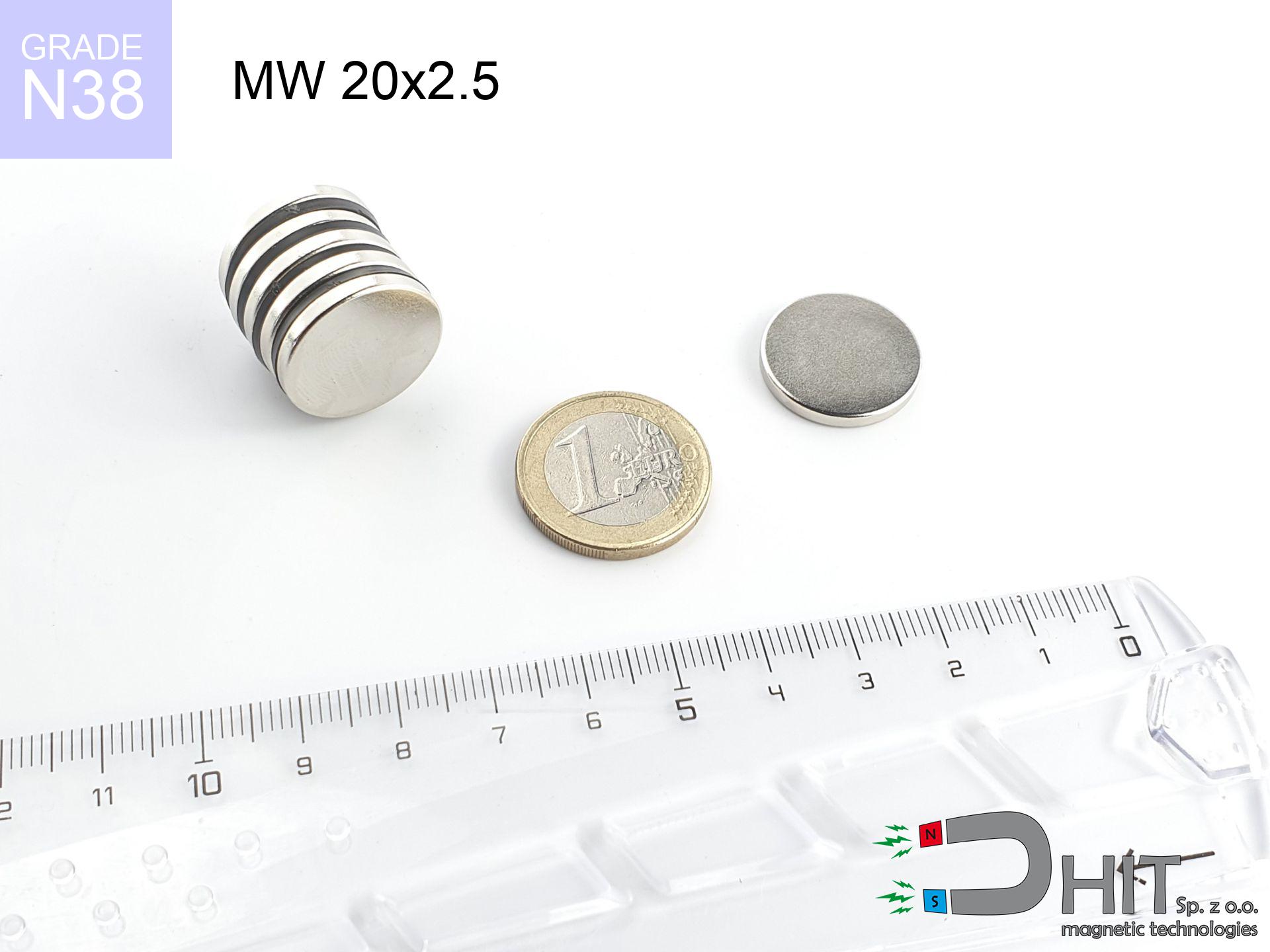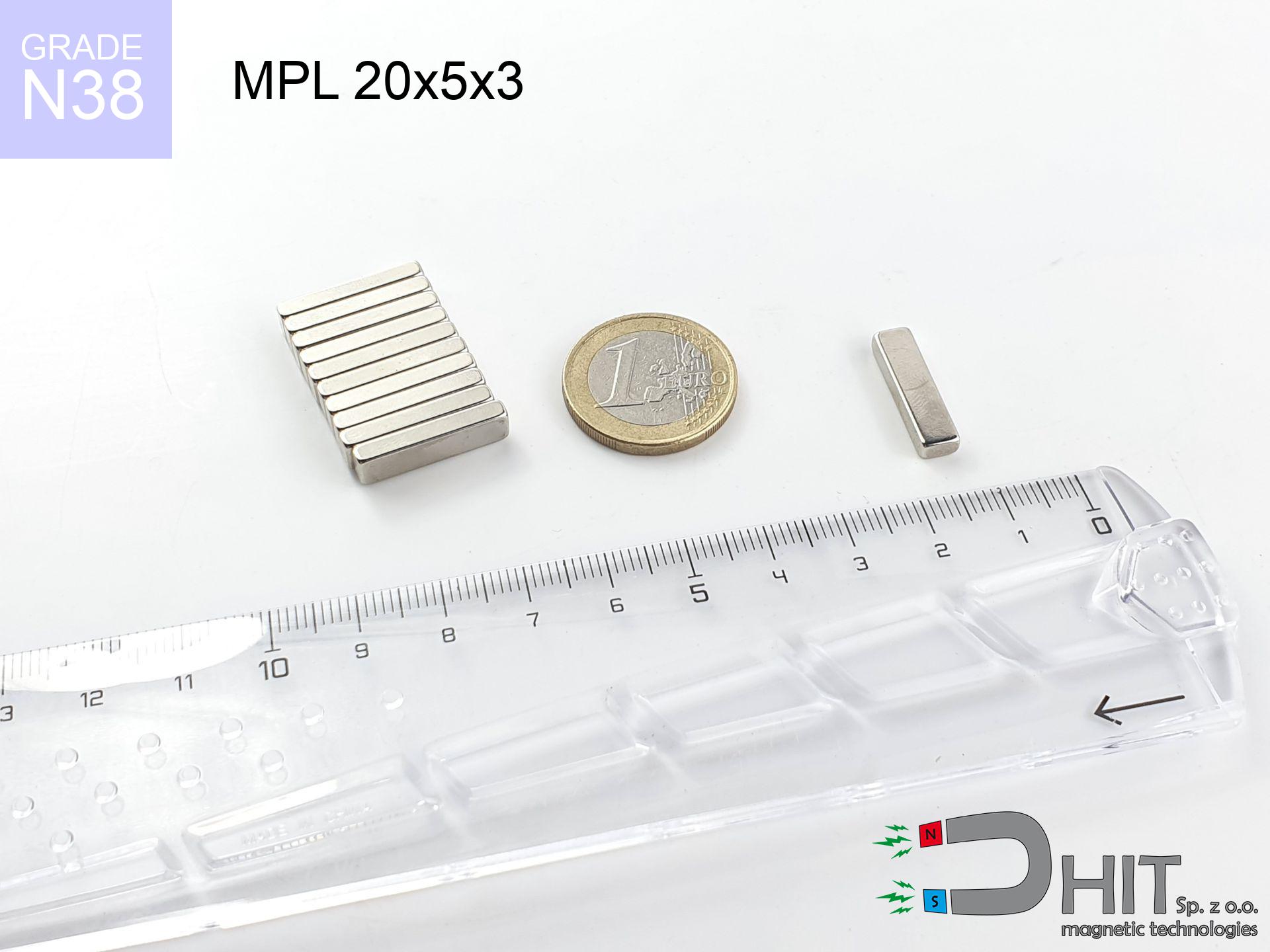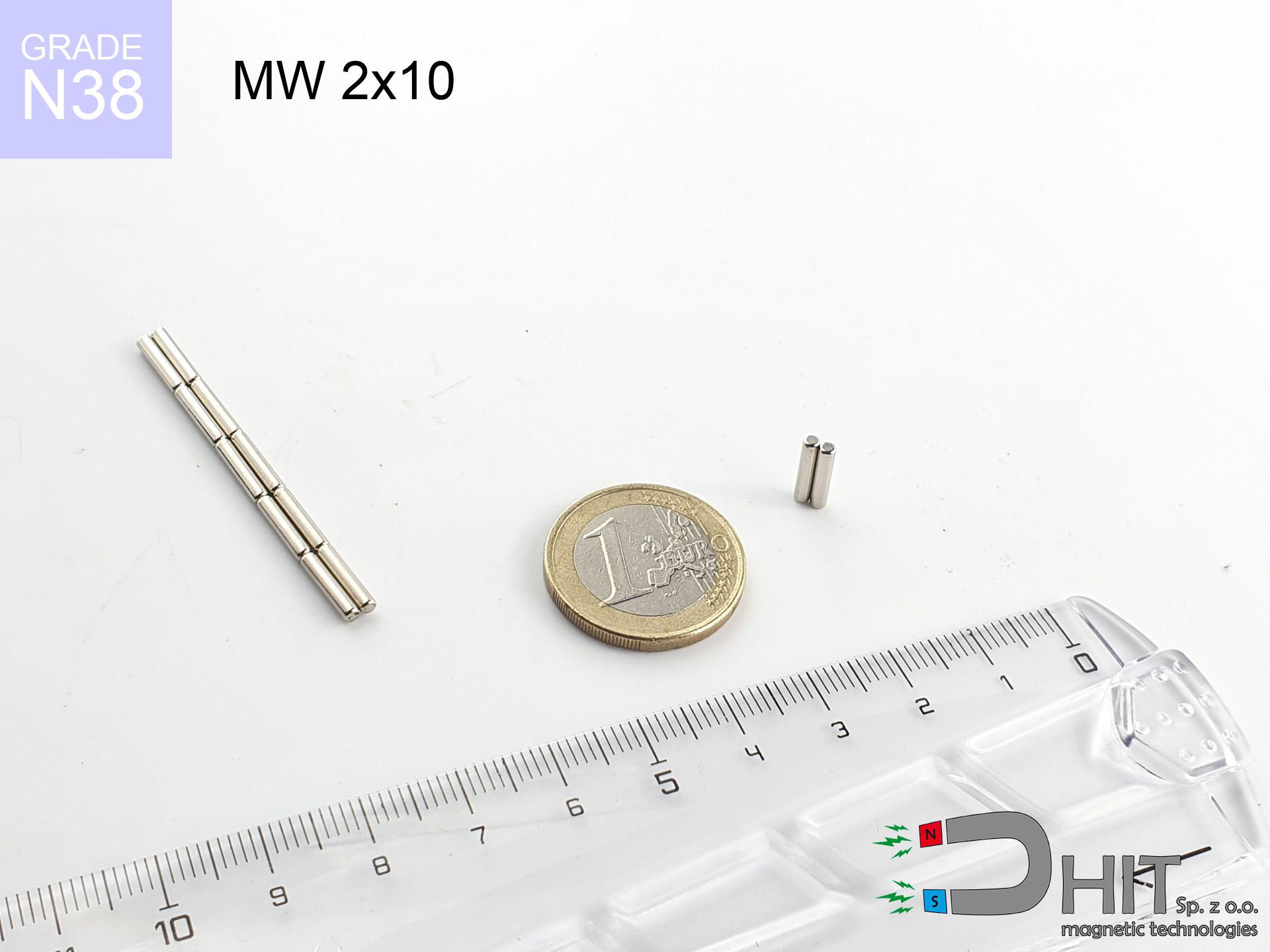MPL 30x20x5 / N38 - lamellar magnet
lamellar magnet
Catalog no 020143
GTIN/EAN: 5906301811497
length
30 mm [±0,1 mm]
Width
20 mm [±0,1 mm]
Height
5 mm [±0,1 mm]
Weight
22.5 g
Magnetization Direction
↑ axial
Load capacity
8.86 kg / 86.90 N
Magnetic Induction
220.03 mT / 2200 Gs
Coating
[NiCuNi] Nickel
9.10 ZŁ with VAT / pcs + price for transport
7.40 ZŁ net + 23% VAT / pcs
bulk discounts:
Need more?Not sure which magnet to buy?
Call us
+48 22 499 98 98
if you prefer send us a note through
contact form
the contact form page.
Parameters as well as structure of neodymium magnets can be analyzed using our
force calculator.
Same-day shipping for orders placed before 14:00.
MPL 30x20x5 / N38 - lamellar magnet
Specification / characteristics MPL 30x20x5 / N38 - lamellar magnet
| properties | values |
|---|---|
| Cat. no. | 020143 |
| GTIN/EAN | 5906301811497 |
| Production/Distribution | Dhit sp. z o.o. |
| Country of origin | Poland / China / Germany |
| Customs code | 85059029 |
| length | 30 mm [±0,1 mm] |
| Width | 20 mm [±0,1 mm] |
| Height | 5 mm [±0,1 mm] |
| Weight | 22.5 g |
| Magnetization Direction | ↑ axial |
| Load capacity ~ ? | 8.86 kg / 86.90 N |
| Magnetic Induction ~ ? | 220.03 mT / 2200 Gs |
| Coating | [NiCuNi] Nickel |
| Manufacturing Tolerance | ±0.1 mm |
Magnetic properties of material N38
| properties | values | units |
|---|---|---|
| remenance Br [min. - max.] ? | 12.2-12.6 | kGs |
| remenance Br [min. - max.] ? | 1220-1260 | mT |
| coercivity bHc ? | 10.8-11.5 | kOe |
| coercivity bHc ? | 860-915 | kA/m |
| actual internal force iHc | ≥ 12 | kOe |
| actual internal force iHc | ≥ 955 | kA/m |
| energy density [min. - max.] ? | 36-38 | BH max MGOe |
| energy density [min. - max.] ? | 287-303 | BH max KJ/m |
| max. temperature ? | ≤ 80 | °C |
Physical properties of sintered neodymium magnets Nd2Fe14B at 20°C
| properties | values | units |
|---|---|---|
| Vickers hardness | ≥550 | Hv |
| Density | ≥7.4 | g/cm3 |
| Curie Temperature TC | 312 - 380 | °C |
| Curie Temperature TF | 593 - 716 | °F |
| Specific resistance | 150 | μΩ⋅cm |
| Bending strength | 250 | MPa |
| Compressive strength | 1000~1100 | MPa |
| Thermal expansion parallel (∥) to orientation (M) | (3-4) x 10-6 | °C-1 |
| Thermal expansion perpendicular (⊥) to orientation (M) | -(1-3) x 10-6 | °C-1 |
| Young's modulus | 1.7 x 104 | kg/mm² |
Engineering modeling of the product - data
Presented information represent the outcome of a physical analysis. Values were calculated on models for the class Nd2Fe14B. Actual parameters may deviate from the simulation results. Treat these data as a supplementary guide for designers.
MPL 30x20x5 / N38
| Distance (mm) | Induction (Gauss) / mT | Pull Force (kg) | Risk Status |
|---|---|---|---|
| 0 mm |
2200 Gs
220.0 mT
|
8.86 kg / 8860.0 g
86.9 N
|
warning |
| 1 mm |
2092 Gs
209.2 mT
|
8.01 kg / 8013.9 g
78.6 N
|
warning |
| 2 mm |
1961 Gs
196.1 mT
|
7.04 kg / 7042.1 g
69.1 N
|
warning |
| 3 mm |
1817 Gs
181.7 mT
|
6.04 kg / 6041.8 g
59.3 N
|
warning |
| 5 mm |
1516 Gs
151.6 mT
|
4.21 kg / 4209.6 g
41.3 N
|
warning |
| 10 mm |
892 Gs
89.2 mT
|
1.46 kg / 1456.2 g
14.3 N
|
weak grip |
| 15 mm |
519 Gs
51.9 mT
|
0.49 kg / 492.4 g
4.8 N
|
weak grip |
| 20 mm |
313 Gs
31.3 mT
|
0.18 kg / 179.8 g
1.8 N
|
weak grip |
| 30 mm |
132 Gs
13.2 mT
|
0.03 kg / 31.9 g
0.3 N
|
weak grip |
| 50 mm |
37 Gs
3.7 mT
|
0.00 kg / 2.5 g
0.0 N
|
weak grip |
MPL 30x20x5 / N38
| Distance (mm) | Friction coefficient | Pull Force (kg) |
|---|---|---|
| 0 mm | Stal (~0.2) |
1.77 kg / 1772.0 g
17.4 N
|
| 1 mm | Stal (~0.2) |
1.60 kg / 1602.0 g
15.7 N
|
| 2 mm | Stal (~0.2) |
1.41 kg / 1408.0 g
13.8 N
|
| 3 mm | Stal (~0.2) |
1.21 kg / 1208.0 g
11.9 N
|
| 5 mm | Stal (~0.2) |
0.84 kg / 842.0 g
8.3 N
|
| 10 mm | Stal (~0.2) |
0.29 kg / 292.0 g
2.9 N
|
| 15 mm | Stal (~0.2) |
0.10 kg / 98.0 g
1.0 N
|
| 20 mm | Stal (~0.2) |
0.04 kg / 36.0 g
0.4 N
|
| 30 mm | Stal (~0.2) |
0.01 kg / 6.0 g
0.1 N
|
| 50 mm | Stal (~0.2) |
0.00 kg / 0.0 g
0.0 N
|
MPL 30x20x5 / N38
| Surface type | Friction coefficient / % Mocy | Max load (kg) |
|---|---|---|
| Raw steel |
µ = 0.3
30% Nominalnej Siły
|
2.66 kg / 2658.0 g
26.1 N
|
| Painted steel (standard) |
µ = 0.2
20% Nominalnej Siły
|
1.77 kg / 1772.0 g
17.4 N
|
| Oily/slippery steel |
µ = 0.1
10% Nominalnej Siły
|
0.89 kg / 886.0 g
8.7 N
|
| Magnet with anti-slip rubber |
µ = 0.5
50% Nominalnej Siły
|
4.43 kg / 4430.0 g
43.5 N
|
MPL 30x20x5 / N38
| Steel thickness (mm) | % power | Real pull force (kg) |
|---|---|---|
| 0.5 mm |
|
0.89 kg / 886.0 g
8.7 N
|
| 1 mm |
|
2.22 kg / 2215.0 g
21.7 N
|
| 2 mm |
|
4.43 kg / 4430.0 g
43.5 N
|
| 5 mm |
|
8.86 kg / 8860.0 g
86.9 N
|
| 10 mm |
|
8.86 kg / 8860.0 g
86.9 N
|
MPL 30x20x5 / N38
| Ambient temp. (°C) | Power loss | Remaining pull | Status |
|---|---|---|---|
| 20 °C | 0.0% |
8.86 kg / 8860.0 g
86.9 N
|
OK |
| 40 °C | -2.2% |
8.67 kg / 8665.1 g
85.0 N
|
OK |
| 60 °C | -4.4% |
8.47 kg / 8470.2 g
83.1 N
|
|
| 80 °C | -6.6% |
8.28 kg / 8275.2 g
81.2 N
|
|
| 100 °C | -28.8% |
6.31 kg / 6308.3 g
61.9 N
|
MPL 30x20x5 / N38
| Gap (mm) | Attraction (kg) (N-S) | Repulsion (kg) (N-N) |
|---|---|---|
| 0 mm |
17.90 kg / 17902 g
175.6 N
3 715 Gs
|
N/A |
| 1 mm |
17.10 kg / 17097 g
167.7 N
4 300 Gs
|
15.39 kg / 15387 g
150.9 N
~0 Gs
|
| 2 mm |
16.19 kg / 16192 g
158.8 N
4 184 Gs
|
14.57 kg / 14573 g
143.0 N
~0 Gs
|
| 3 mm |
15.23 kg / 15228 g
149.4 N
4 058 Gs
|
13.71 kg / 13706 g
134.5 N
~0 Gs
|
| 5 mm |
13.22 kg / 13216 g
129.6 N
3 780 Gs
|
11.89 kg / 11894 g
116.7 N
~0 Gs
|
| 10 mm |
8.51 kg / 8506 g
83.4 N
3 033 Gs
|
7.66 kg / 7655 g
75.1 N
~0 Gs
|
| 20 mm |
2.94 kg / 2942 g
28.9 N
1 784 Gs
|
2.65 kg / 2648 g
26.0 N
~0 Gs
|
| 50 mm |
0.15 kg / 146 g
1.4 N
398 Gs
|
0.13 kg / 132 g
1.3 N
~0 Gs
|
MPL 30x20x5 / N38
| Object / Device | Limit (Gauss) / mT | Safe distance |
|---|---|---|
| Pacemaker | 5 Gs (0.5 mT) | 10.5 cm |
| Hearing aid | 10 Gs (1.0 mT) | 8.5 cm |
| Mechanical watch | 20 Gs (2.0 mT) | 6.5 cm |
| Mobile device | 40 Gs (4.0 mT) | 5.0 cm |
| Remote | 50 Gs (5.0 mT) | 4.5 cm |
| Payment card | 400 Gs (40.0 mT) | 2.0 cm |
| HDD hard drive | 600 Gs (60.0 mT) | 1.5 cm |
MPL 30x20x5 / N38
| Start from (mm) | Speed (km/h) | Energy (J) | Predicted outcome |
|---|---|---|---|
| 10 mm |
21.97 km/h
(6.10 m/s)
|
0.42 J | |
| 30 mm |
34.74 km/h
(9.65 m/s)
|
1.05 J | |
| 50 mm |
44.76 km/h
(12.43 m/s)
|
1.74 J | |
| 100 mm |
63.29 km/h
(17.58 m/s)
|
3.48 J |
MPL 30x20x5 / N38
| Technical parameter | Value / Description |
|---|---|
| Coating type | [NiCuNi] Nickel |
| Layer structure | Nickel - Copper - Nickel |
| Layer thickness | 10-20 µm |
| Salt spray test (SST) ? | 24 h |
| Recommended environment | Indoors only (dry) |
MPL 30x20x5 / N38
| Parameter | Value | SI Unit / Description |
|---|---|---|
| Magnetic Flux | 14 969 Mx | 149.7 µWb |
| Pc Coefficient | 0.26 | Low (Flat) |
MPL 30x20x5 / N38
| Environment | Effective steel pull | Effect |
|---|---|---|
| Air (land) | 8.86 kg | Standard |
| Water (riverbed) |
10.14 kg
(+1.28 kg Buoyancy gain)
|
+14.5% |
1. Vertical hold
*Note: On a vertical wall, the magnet retains only ~20% of its perpendicular strength.
2. Efficiency vs thickness
*Thin steel (e.g. 0.5mm PC case) drastically limits the holding force.
3. Heat tolerance
*For N38 grade, the safety limit is 80°C.
4. Demagnetization curve and operating point (B-H)
chart generated for the permeance coefficient Pc (Permeance Coefficient) = 0.26
This simulation demonstrates the magnetic stability of the selected magnet under specific geometric conditions. The solid red line represents the demagnetization curve (material potential), while the dashed blue line is the load line based on the magnet's geometry. The Pc (Permeance Coefficient), also known as the load line slope, is a dimensionless value that describes the relationship between the magnet's shape and its magnetic stability. The intersection of these two lines (the black dot) is the operating point — it determines the actual magnetic flux density generated by the magnet in this specific configuration. A higher Pc value means the magnet is more 'slender' (tall relative to its area), resulting in a higher operating point and better resistance to irreversible demagnetization caused by external fields or temperature. A value of 0.42 is relatively low (typical for flat magnets), meaning the operating point is closer to the 'knee' of the curve — caution is advised when operating at temperatures near the maximum limit to avoid strength loss.
Material specification
| iron (Fe) | 64% – 68% |
| neodymium (Nd) | 29% – 32% |
| boron (B) | 1.1% – 1.2% |
| dysprosium (Dy) | 0.5% – 2.0% |
| coating (Ni-Cu-Ni) | < 0.05% |
Environmental data
| recyclability (EoL) | 100% |
| recycled raw materials | ~10% (pre-cons) |
| carbon footprint | low / zredukowany |
| waste code (EWC) | 16 02 16 |
Other offers
Pros as well as cons of neodymium magnets.
Benefits
- They have constant strength, and over around 10 years their performance decreases symbolically – ~1% (in testing),
- They are extremely resistant to demagnetization induced by presence of other magnetic fields,
- A magnet with a smooth gold surface looks better,
- Neodymium magnets ensure maximum magnetic induction on a small surface, which increases force concentration,
- Through (adequate) combination of ingredients, they can achieve high thermal resistance, allowing for functioning at temperatures reaching 230°C and above...
- Thanks to the possibility of flexible molding and adaptation to specialized needs, neodymium magnets can be created in a broad palette of geometric configurations, which expands the range of possible applications,
- Wide application in modern industrial fields – they serve a role in data components, motor assemblies, medical devices, and technologically advanced constructions.
- Compactness – despite small sizes they generate large force, making them ideal for precision applications
Cons
- To avoid cracks under impact, we suggest using special steel holders. Such a solution secures the magnet and simultaneously increases its durability.
- When exposed to high temperature, neodymium magnets suffer a drop in strength. Often, when the temperature exceeds 80°C, their power decreases (depending on the size, as well as shape of the magnet). For those who need magnets for extreme conditions, we offer [AH] versions withstanding up to 230°C
- Due to the susceptibility of magnets to corrosion in a humid environment, we advise using waterproof magnets made of rubber, plastic or other material stable to moisture, in case of application outdoors
- Due to limitations in realizing nuts and complicated shapes in magnets, we propose using cover - magnetic holder.
- Possible danger resulting from small fragments of magnets can be dangerous, when accidentally swallowed, which is particularly important in the aspect of protecting the youngest. Furthermore, small elements of these magnets can disrupt the diagnostic process medical when they are in the body.
- High unit price – neodymium magnets cost more than other types of magnets (e.g. ferrite), which increases costs of application in large quantities
Holding force characteristics
Optimal lifting capacity of a neodymium magnet – what it depends on?
- using a plate made of mild steel, serving as a magnetic yoke
- whose transverse dimension is min. 10 mm
- with a surface perfectly flat
- with direct contact (no paint)
- under vertical force direction (90-degree angle)
- at ambient temperature approx. 20 degrees Celsius
What influences lifting capacity in practice
- Space between surfaces – every millimeter of distance (caused e.g. by varnish or dirt) diminishes the magnet efficiency, often by half at just 0.5 mm.
- Loading method – declared lifting capacity refers to detachment vertically. When applying parallel force, the magnet holds significantly lower power (often approx. 20-30% of maximum force).
- Steel thickness – insufficiently thick plate does not close the flux, causing part of the flux to be wasted into the air.
- Metal type – not every steel reacts the same. Alloy additives weaken the attraction effect.
- Surface condition – smooth surfaces guarantee perfect abutment, which improves force. Rough surfaces weaken the grip.
- Thermal conditions – neodymium magnets have a negative temperature coefficient. At higher temperatures they lose power, and at low temperatures gain strength (up to a certain limit).
Lifting capacity testing was conducted on a smooth plate of optimal thickness, under perpendicular forces, however under attempts to slide the magnet the lifting capacity is smaller. In addition, even a slight gap between the magnet’s surface and the plate lowers the holding force.
Nickel coating and allergies
A percentage of the population experience a sensitization to nickel, which is the typical protective layer for NdFeB magnets. Extended handling can result in skin redness. We suggest wear safety gloves.
Do not drill into magnets
Machining of NdFeB material poses a fire hazard. Magnetic powder oxidizes rapidly with oxygen and is hard to extinguish.
Powerful field
Use magnets with awareness. Their powerful strength can surprise even experienced users. Be vigilant and respect their force.
Danger to the youngest
Always keep magnets away from children. Risk of swallowing is significant, and the consequences of magnets connecting inside the body are fatal.
Medical implants
Health Alert: Strong magnets can deactivate heart devices and defibrillators. Stay away if you have medical devices.
Power loss in heat
Monitor thermal conditions. Exposing the magnet to high heat will permanently weaken its properties and pulling force.
Crushing risk
Pinching hazard: The attraction force is so immense that it can result in blood blisters, crushing, and even bone fractures. Use thick gloves.
Phone sensors
A strong magnetic field disrupts the functioning of magnetometers in smartphones and GPS navigation. Maintain magnets close to a device to prevent breaking the sensors.
Protective goggles
Despite metallic appearance, neodymium is brittle and cannot withstand shocks. Do not hit, as the magnet may crumble into hazardous fragments.
Magnetic media
Do not bring magnets close to a wallet, laptop, or screen. The magnetism can permanently damage these devices and erase data from cards.


